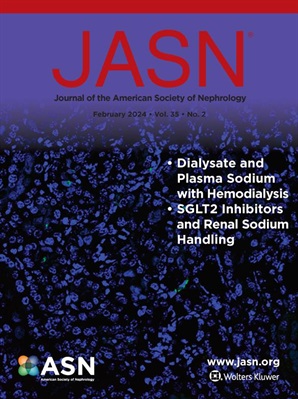机械拉伸足细胞的选择性剪接作为肾小球高血压的模型。
IF 10.3
1区 医学
Q1 UROLOGY & NEPHROLOGY
引用次数: 0
摘要
背景:前mrna剪接的改变对各种疾病的病理生理至关重要。然而,选择性剪接mRNA对高血压肾病足细胞的影响尚不清楚。Sys_CARE项目旨在确定参与肾小球高血压发生和进展的其他剪接事件。方法:机械拉伸小鼠足细胞后,通过蛋白质组学、RNA测序和几种生物信息学替代剪接工具分析蛋白质和mRNA。结果:通过转录组学和蛋白质组学分析,我们发现机械拉伸导致基因表达和蛋白质丰度发生显著变化。RNA-Seq鉴定了3000多个机械拉伸后的选择性剪接基因,包括所有类型的选择性剪接事件。其中,17个基因在四种不同的剪接分析工具中表现出选择性剪接事件。在这一组中,我们重点研究了my16(肌球蛋白蛋白复合物的一种成分)和Shroom3(足细胞功能必需的一种肌动蛋白结合蛋白)。通过qRT-PCR和原位杂交,我们鉴定出两个Shroom3同种异构体在机械拉伸下表达显著变化。此外,我们观察到机械拉伸后两个my16亚型的表达开关,并伴有c端氨基酸序列的改变。结论:对机械拉伸足细胞进行的全面RNA-Seq分析发现了新的潜在足细胞特异性生物标志物,并突出了显著的替代剪接事件,特别是在Shroom3和my16的mRNA中。本文章由计算机程序翻译,如有差异,请以英文原文为准。
Alternative Splicing in Mechanically Stretched Podocytes as a Model of Glomerular Hypertension.
求助全文
通过发布文献求助,成功后即可免费获取论文全文。
去求助
来源期刊
CiteScore
22.40
自引率
2.90%
发文量
492
审稿时长
3-8 weeks
期刊介绍:
The Journal of the American Society of Nephrology (JASN) stands as the preeminent kidney journal globally, offering an exceptional synthesis of cutting-edge basic research, clinical epidemiology, meta-analysis, and relevant editorial content. Representing a comprehensive resource, JASN encompasses clinical research, editorials distilling key findings, perspectives, and timely reviews.
Editorials are skillfully crafted to elucidate the essential insights of the parent article, while JASN actively encourages the submission of Letters to the Editor discussing recently published articles. The reviews featured in JASN are consistently erudite and comprehensive, providing thorough coverage of respective fields. Since its inception in July 1990, JASN has been a monthly publication.
JASN publishes original research reports and editorial content across a spectrum of basic and clinical science relevant to the broad discipline of nephrology. Topics covered include renal cell biology, developmental biology of the kidney, genetics of kidney disease, cell and transport physiology, hemodynamics and vascular regulation, mechanisms of blood pressure regulation, renal immunology, kidney pathology, pathophysiology of kidney diseases, nephrolithiasis, clinical nephrology (including dialysis and transplantation), and hypertension. Furthermore, articles addressing healthcare policy and care delivery issues relevant to nephrology are warmly welcomed.

 求助内容:
求助内容: 应助结果提醒方式:
应助结果提醒方式:


